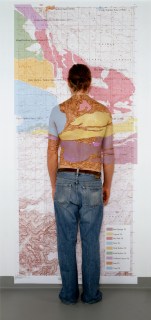The Back of the Map at the Center for Art + Environment, Nevada Museum of Art

Erika Osborne’s exhibitionThe Back of the Map at the Center for Art + Environment translates her firsthand experiences in the landscape to something like a field guide: small drawings of sites, found objects, handmade booklets, and photographs of large-scale maps paired with people.
In one series, Mapping Bodily Connections, as well as Imprinting Place, Osborne paints topographical lines onto the skin of people posed in front of corresponding maps and landscapes. The map in general documents human understanding of the land; the part painted on the figure simulates this while also noting the inverse: the landscape’s indelible imprint on self and consciousness. Blank space in the shape of figural silhouettes show up in several of the large-scale maps, and sharing a sensibility with John Cage’s 4’33” or Rauschenberg’s white canvases, the pieces bear an impression of the invisible, and a chance to fill in the blank.


Other works more boldly represent Osborne’s gaze (sometimes the gaze of the figures themselves in her photographs), as she assumes the role of both explorer and guide. Way-finding is an critical component to her practice. Having helped run the University of New Mexico’s (UNM) Land Arts of the American West program, she is attuned to living and practicing in the environment, sometimes for several months at a time. In recent years Osborne started Art and Environment and Place: Appalachia, a program which similarly explores art-making in the landscape first-hand, this time at West Virginia University where she teaches. Proximity to land and to these programs has been essential to her practice–influencing how she thinks about the body, land use, and its interpretation.

The body as a subject of map-based art is certainly not new, but The Back of the Map compellingly steers viewers to a unique appreciation of the landscape: slowing us to acknowledge the limitations of maps. In an age when so much is charted, and so little seemingly undiscovered, we’re reminded of the distinction between representation and reality, each offering a singular experience unlike the other, and the land itself rich with possibilities. As all good maps do, Osborne’s work illustrates information–we ought not to overlook what it means to experience the land ourselves.
Installation at Center for Art + Environment. Courtesy of Nevada Museum of Art.


There are no comments
Add yours